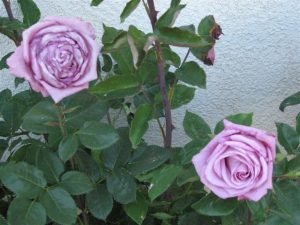Some gardeners will not have roses, thinking they are too “fussy,” addicted to poison sprays and always coming down with blackspot or powdery mildew. That is not entirely true, and as for those hybrid teas and floribundas that are more disease prone, who is the culprit?
Rosa foetida is! Before the start of the twentieth century, domesticated hybrid roses, first created in gardens of ancient Rome and in China, came from parents that evolved in a cool temperate climate and had to fight off fungus and cold. But these hardy heritage varieties came in limited colors: yellow, orange and flame-red. After long, hard work, gifted breeder Joseph Pernet-Ducher finally got crosses with a double form of Rosa foetida and created Stella d’Oro.
Now fabulous new flower colors and huge blooms were created for hybrid teas and floribundas -but at a great price. Unfortunately, the little golden-flowered Rosa foetida is from Iran’s sandy soil and hot, dry climate, where it evolved without blackspot resistance and cold hardiness. So…what that means is that different gardeners should learn more and shop carefully for individual wants and needs, before buying roses. If you love huge hybrid teas, or if a certain variety has memories and sentimental value to you, you may consider it worth its fussiness and addiction to fungicide sprays. But if you want an organic yard, or just less fussing, spraying and fertilizing, perhaps the tough old heritage rose varieties with no Rosa foetida in their pedigree, would work for you.
Other rose-related wants may include strong-scented varieties for those who must have perfume or non-scented blooms for gardeners troubled by allergies. Some recent rose breeders have been attempting to work back to more cold hardiness and fungal disease resistance. And, of course, good cultural practices like getting rid of (NOT composting!) fallen disease-riddled leaves will help.
Now is the time to prune roses. According to the University of California Integrated Pest Management site, http://ipm.ucanr.edu/PMG/PESTNOTES/pn7465.html, “Pruning provides an opportunity to direct growth and invigorate rose plants. Pruning requirements vary among types of rose plants. Hybrid teas, grandifloras, and many floribundas benefit from annual pruning in which most top growth is removed leaving three to five canes in a vase-shaped configuration. Landscape varieties may be hedged or left unpruned, although rejuvenation pruning or removal of older stems every two to three years will renew vigor in the planting. In most of California, pruning should be done in winter before buds swell, although it may be delayed where late spring frosts are common. A starting point in pruning is to remove diseased and damaged wood. Between one-third and two-thirds of healthy wood may be removed through a combination of heading and thinning cuts, which should be within 1/4 inch above outwardly growing lateral buds or branches. Removal of more wood results in fewer but larger flowers with longer stems; less pruning preserves the size of plants and results in a greater number of smaller flowers. Pruning paint or other wound dressings are not necessary.
During the growing season, the rule-of-thumb for cutting blooms on first-year plants is to make the cut above the first outwardly facing five-leaflet leaf. On well-established plants, cut blooms somewhat lower to insure new canes can support the weight of the blooms. Removal of spent rose blossoms allows the plant to conserve energy and leads to further flower production. To deadhead a rose plant, use the same guidelines as those for cutting blooms. Landscape varieties do not need to be deadheaded.”
Fussy or not, everyone can agree that roses are a beautiful addition to any garden. Cut roses are also a lovely addition to any table. Plan now for beautiful summer blooms. The UCCE Master Gardener Demonstration Garden located at 251 South Barretta Street, Sonora, ca. will feature a demonstration of rose pruning on February 4, 2017.
Original article written by Pat Reh, former UCCE Master Gardener and current member of California Native Plant Society. Editing and IPM information was provided by Francie McGowan, University of California Cooperative Extension Master Gardener of Tuolumne County.




